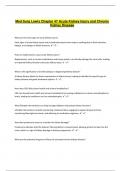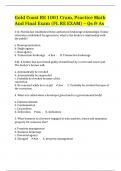Med Surg Lewis Chapter 47 Acute Kidney Injury and Chronic
Kidney Disease
What are the early signs of acute kidney injury?
Early signs of acute kidney injury may include decreased urine output, swelling due to fluid retention,
fatigue, and changes in blood pressure. ✔️✔️
How can nephrotoxins cause acute kidney injury?
Nephrotoxins, such as certain medications and heavy metals, can directly damage the renal cells, leading
to impaired kidney function and acute kidney injury. ✔️✔️
What is the significance of a kidney biopsy in diagnosing kidney disease?
A kidney biopsy allows for direct examination of kidney tissue, helping to identify the specific type of
kidney disease and guide treatment options. ✔️✔️
How does CKD affect bone health and mineral metabolism?
CKD can disrupt bone health and mineral metabolism by causing imbalances in calcium and phosphorus
levels, leading to conditions such as osteodystrophy. ✔️✔️
What lifestyle interventions can help manage diabetes and protect kidney function?
Lifestyle interventions include maintaining a balanced diet, engaging in regular physical activity,
monitoring blood glucose levels, and adhering to medication regimens. ✔️✔️
How does proteinuria serve as a marker for kidney damage?
Proteinuria indicates that the kidneys' filtering ability is compromised, allowing protein to leak into the
urine, which is a sign of kidney damage or disease progression. ✔️✔️
What are the potential long-term effects of untreated chronic kidney disease?
,Untreated chronic kidney disease can lead to complications such as cardiovascular disease, anemia,
bone disease, and ultimately end-stage renal disease requiring dialysis or transplant. ✔️✔️
How does the presence of diabetes complicate the management of CKD?
Diabetes complicates CKD management by increasing the risk of progression to kidney failure, requiring
careful monitoring and control of blood sugar and blood pressure levels. ✔️✔️
What are the benefits of a low-protein diet for CKD patients?
A low-protein diet can reduce the buildup of nitrogenous waste products, thereby decreasing the
workload on the kidneys and potentially slowing the progression of CKD. ✔️✔️
How can education and awareness about kidney disease improve patient outcomes?
Education and awareness empower patients to recognize symptoms early, adhere to treatment plans,
and make lifestyle changes, ultimately improving health outcomes. ✔️✔️
What are the signs of electrolyte imbalances in CKD patients?
Signs of electrolyte imbalances may include muscle cramps, irregular heartbeat, weakness, confusion,
and changes in urine output, necessitating prompt evaluation. ✔️✔️
How can regular monitoring of kidney function help in CKD management?
Regular monitoring of kidney function through blood tests and urine analysis helps track disease
progression, adjust treatment plans, and prevent complications. ✔️✔️
What role does dietary phosphorus play in kidney health?
Excess dietary phosphorus can lead to hyperphosphatemia in CKD patients, contributing to bone disease
and cardiovascular risk, making dietary management essential. ✔️✔️
How do ACE inhibitors help protect kidney function in patients with diabetes?
ACE inhibitors help protect kidney function by lowering blood pressure, reducing proteinuria, and
providing renal protective effects, particularly in diabetic patients. ✔️✔️
,What are the psychological impacts of living with chronic kidney disease?
Living with chronic kidney disease can lead to anxiety, depression, and stress due to the demands of
treatment, lifestyle changes, and potential health complications. ✔️✔️
How can a patient advocate play a role in kidney disease management?
A patient advocate can support individuals in navigating the healthcare system, accessing resources, and
ensuring that their needs and concerns are addressed in their care. ✔️✔️
What are intrarenal causes of acute kidney injury (AKI) (select all that apply)?
a. Anaphylaxis
b. Renal stones
c. Bladder cancer
d. Nephrotoxic drugs
e. Acute glomerulonephritis
f. Tubular obstruction by myoglobin ✔️✔️d, e, f. Intrarenal causes of acute kidney injury (AKI)
include conditions that cause direct damage to the
kidney tissue, including nephrotoxic drugs, acute
glomerulonephritis, and tubular obstruction by myoglobin, or prolonged ischemia. Anaphylaxis and
other prerenal problems are frequently the initial cause of AKI. Renal stones and bladder cancer are
among the postrenal causes of AKI.
An 83-year-old female patient was found lying on the bathroom floor. She said she fell 2 days ago and
has not been
able to take her heart medicine or eat or drink anything since then. What conditions could be causing
prerenal AKI in
this patient (select all that apply)?
a. Anaphylaxis
b. Renal calculi
c. Hypovolemia
d. Nephrotoxic drugs
e. Decreased cardiac output ✔️✔️c, e. Because the patient has had nothing to eat or drink
, for 2 days, she is probably dehydrated and hypovolemic.
Decreased cardiac output (CO) is most likely because she is older and takes heart medicine, which is
probably for heart failure or hypertension. Both hypovolemia and decreased CO cause prerenal AKI.
Anaphylaxis is also a cause of prerenal AKI but is not likely in this situation. Nephrotoxic drugs would
contribute to intrarenal causes of AKI and renal calculi would be a postrenal cause of AKI.
Acute tubular necrosis (ATN) is the most common cause of intrarenal AKI. Which patient is most likely to
develop ATN?
a. Patient with diabetes mellitus
b. Patient with hypertensive crisis
c. Patient who tried to overdose on acetaminophen
d. Patient with major surgery who required a blood transfusion ✔️✔️d. Acute tubular necrosis (ATN) is
primarily the result
of ischemia, nephrotoxins, or sepsis. Major surgery
is most likely to cause severe kidney ischemia in the
patient requiring a blood transfusion. A blood transfusion
hemolytic reaction produces nephrotoxic injury if it occurs.
Diabetes mellitus, hypertension, and acetaminophen
overdose will not contribute to ATN.
Priority Decision: A dehydrated patient is in the Injury stage of the RIFLE staging of AKI. What would the
nurse
first anticipate in the treatment of this patient?
a. Assess daily weight
b. IV administration of fluid and furosemide (Lasix)
c. IV administration of insulin and sodium bicarbonate
d. Urinalysis to check for sediment, osmolality, sodium, and specific gravity ✔️✔️b. Injury is the stage
of RIFLE classification when urine
output is less than 0.5 mL/kg/hr for 12 hours, the serum
creatinine is increased times two or the glomerular
filtration rate (GFR) is decreased by 50%. This stage may





